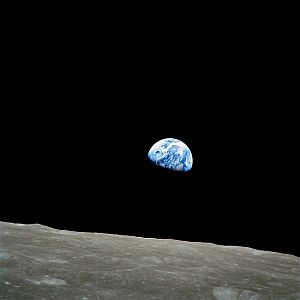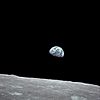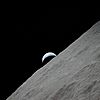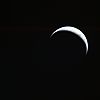Earth phase facts for kids

Earthrise, by Apollo 8 astronaut William Anders, December, 1968, half phase of Earth as seen from the Moon
|
|
The Earth phase is how our planet Earth looks from the Moon. Just like the Moon changes its shape in our sky, the Earth also changes its shape when seen from the Moon. These changes happen in a cycle over about a month. This is because the Moon moves around the Earth, and the Earth moves around the Sun.
How Earth Looks from the Moon
One of the most amazing things to see in the Moon's sky is Earth! Earth looks much bigger from the Moon than the Moon looks from Earth. In fact, Earth appears about four times larger.
Just like the Moon has phases (like a full moon or a crescent moon), Earth also has phases when seen from the Moon. But here's a cool fact: the phases are opposite! When we see a "full Moon" from Earth, someone on the Moon would see a "new Earth" (meaning the side facing them is dark). And when we see a "new Moon," they see a "full Earth."
Earth is also much brighter than the Moon. This is partly because Earth has white clouds that reflect a lot of sunlight. A "full Earth" glows over 50 times brighter than a "full Moon" does for us. This bright Earth light can even be seen from Earth, shining on the dark part of the Moon. We call this Earthshine.
Because the Moon spins at the same rate it orbits Earth (this is called synchronous rotation), one side of the Moon always faces Earth. This is called the "near side." The other side, the "far side," mostly cannot be seen from Earth. This means you can only see Earth if you are on the near side of the Moon. If you were on the far side, Earth would always be out of sight.
Even though the Moon always shows us the same side, it does wobble a little bit. This wobble is called libration. Because of this wobble, Earth appears to move slowly in the Moon's sky. It traces out a small oval shape once a month. The exact shape of this oval depends on where you are on the Moon. So, if you are near the edge of the near side, Earth might sometimes dip below the horizon and then rise again.
It's important to know that while many real photos of Earth from the Moon exist (especially from NASA), some pictures shared online might not be real.
Eclipses from the Moon
Sometimes, the Earth and the Sun line up in the lunar sky, causing an eclipse.
When the Moon passes through Earth's shadow, we on Earth see a lunar eclipse. But if you were on the Moon during this time, you would see a solar eclipse! The Earth would pass in front of the Sun. Since Earth looks four times bigger than the Sun from the Moon, the Sun would be hidden for hours. You would see Earth's atmosphere glowing like a reddish ring around the dark Earth. During the Apollo 15 mission, astronauts tried to film this with a TV camera, but it didn't work.
What about when the Moon blocks the Sun's light to Earth? We call this a Solar eclipse. For an observer on the Moon looking at Earth, this would not be as dramatic. The Moon's shadow (called the umbra) is very small by the time it reaches Earth's surface. You might see a blurry dark spot moving across Earth's disk. It would look a bit like the shadow of a golf ball from about 5 meters (16 feet) away. Scientists on the Moon with strong telescopes might see the dark spot in the middle of a lighter shadow (the penumbra). This is similar to how the Deep Space Climate Observatory satellite sees it from its spot far away from Earth.
So, whenever an eclipse happens on Earth, an eclipse of a different kind is also happening on the Moon. Eclipses occur for both Earth and Moon observers when the Sun, Earth, and Moon line up perfectly.
Phases of the Earth
- Earth phases
Related pages
- Earthrise
- Extraterrestrial sky
- Pale Orange Dot (Early Earth)
- Phases of the Moon
- Spaceship Earth
- The Blue Marble


















